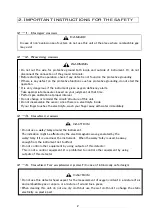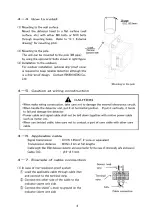
2
2. IMPORTANT INSTRUCTIONS FOR THE SAFETY
2-1.Danger cases
2-2.Warning cases
2-3.Caution cases
2-4.Caution for explosion proof (In case of intrinsically safe design)
In case of non-explosion poof system, do not use this unit at the place where combustible gas
may exist.
・Do not cut the wire for protective ground both inside and outside of instrument. Or, do not
disconnect the connection of the ground terminals.
・Before starting the operation, check if any defect is not found on the protective grounding.
・If there is any defect on the protective functions such as protective grounding, do not start the
operation.
・It is very dangerous if the instrument gives oxygen deficiency alarm.
Take appropriate measures based on your judgment at that time.
・Perform gas calibration at proper interval.
・Do not change or remodel the circuit/structure of this unit.
・Do not disassemble the sensor since there is a electrolyte inside.
If your finger touches the electrolyte, wash your finger away with water immediately.
WARNING
・Do not use a walky-talky around the instrument.
The indication might be affected by the electromagnetic wave generated by the
walky-talky if it is used near the instrument. When the walky-talky is used, be away
enough from the instrument not to affect.
・Do not control other equipment by using outputs of this detector.
This is not a control equipment. It is prohibited to control other equipment by using
outputs of this detector.
CAUTION
・Do not use this detector head expect for the measurement of oxygen content in a mixture of air
and combustible gas or vapors, or a mixture of air and toxic gases.
・When cleaning this unit, do not use dry cloth but use the wet cloth not to change the static
electricity on plastic part.
CAUTION
DANGER
Summary of Contents for GD-F4A-SC-A
Page 1: ...Oxygen Gas Detector Head GD F4A SC A Operating Manual PT2 152 PT2E 2510...
Page 6: ......
Page 11: ......
Page 19: ......
Page 24: ......
Page 26: ...Manual Log Rev Amendment Issue data 0 First issue 2018 2 9...






































